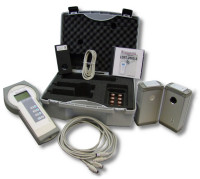This product is no longer manufactured. Remaining stock may still be available. Please refer to the alternatives listed below under "Similar products" or contact us directly.
Alternative Products for this discontinued product:
SphereSpectro 150H
Patented Spectrophotometer for determining the spectral absorption coefficient and effective scattering coefficient of scattering or turbid media.
- Spectrophotometer for determining the spectral absorption coefficient and effective scattering coefficient of scattering media
- For clear samples the classical 8°/d measurement geometry is supported
- Different stages of expansion in the spectral range UV, VIS to IR
- Patented Measuring System
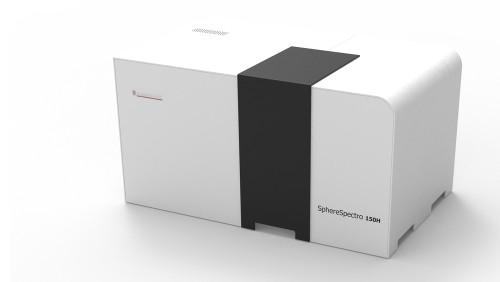
The SphereSpectro 150H is a unique spectrophotometer system for simultaneously discriminating and quantifying both the spectral absorption coefficient and the spectral effective scattering coefficient of scattering media (patented). Different versions are available for the UV, VIS and IR spectral ranges. For clear samples the classical 8°/d measurement geometry can be applied.
Spectrophotometers main Features on a glance:
- Simultaneous determination of:
- Absorption coefficient, µa
- effective scattering coefficient, µs‘
- Measurement on diffuse samples (solid or liquid)
- Measurement in classical 8°/d measurement geometry for clear probes (according to DIN 5036-3 as well as CIE-130-1998)
- Easy sample handling
- Measurement within seconds
- Table top device
- UV, VIS and IR spectral ranges
- Large sample compartment with several probe fixing options
- Precise and absolute measurements
- Plug & play with intuitive software package
The fundamental measurement principle enables the measurement of both parameters, spectral absorption coefficient and spectral effective scattering coefficient. These two parameters are of interest for analyzing diffuse scattering samples based on their physical and chemical properties. Other laboratory measurement devices on the market perform the measurement and analysis based on the absorption or pure transmission only. This is not sufficient when an absolute measurement and more profound and deeper analysis of diffuse scattering samples is needed. Due to a specific algorithm in the software program, the absorption coefficient as well as the scattering coefficient can be determined. This is based on “radiative transport theory”. Further explanation can be found in these scientific publications, see following links: Absorption and Scattering of diffuse media: Theory and Absorption and Scattering of diffuse media: Experiment.
Due to this unique measuring principle, it enables serving many different applications. Some examples follow:
Applications of the SphereSpectro 150H Spectrophotometer
- Material Analysis (e.g. ingredients, concentration)
- Biophotonics (e.g. meausurement of Tissue phantoms)
- Active ingredient determinations
- Quality assurance (e.g. quality control of metalworking fluids)
- Chemometrics
- Food analysis (e.g. ingredients, concentration)
- Pharmacy and cosmetics (e.g. measurements of facial cream)
- Physical parameter based rendering (e.g. rendering of tooth)
See also our application related scientific publication about the Simultaneous Determination of Droplet Size, pH Value and Concentration to Evaluate the Aging Behavior of Metalworking Fluids.
See our publication about the possibility Improved Process Control by Using the Effective Scattering Coefficients to Determine the Fat Content in Homogenized Cow-Based Milk with Multivariate Data Modeling.
See a publication about Microscopic and Spectroscopic Study on Phase Separation in Highly Crosslinked Biobased Polyurethane Thermosets, which shows the potential of the SphereSpectro in such analysis tasks.
Typical Spectrophotometer vs. SphereSpectro 150H Spectrophotometer
The challenge with the measurement of scattering media is that it cannot be comprehensively measured and analyzed with classic "spectrophotometers". This is because these typically only utilize the transmitted light and cannot differentiate between scattering and absorption. Spectrophotometers are an ideal measuring system for transparent / clear samples, but reach their limits with scattering samples. The measuring system described here is necessary for this kind of sample.
Whenever the measurement of absolute scattering and absorption coefficients is required, a typical spectrophotometer cannot fulfill the job. The SphereSpectro 150H is capable of measuring absolute values and therefore allows analysis of physical and chemical material properties based on the absolute measurement of absorption and scattering characteristics. For example, this kind of information is of interest for determining concentration levels or material properties in cross-linking processes. Another example is the determination of a sample’s appearance in rendering processes based on the absolute absorption and scattering values of the sample. This is typically of interest in dental applications or similar.
The sample preparation of the SphereSpectro 150H is much easier compared to conventional spectrophotometers. Solid translucent samples can be simply held with the sample holder. Liquid samples can be easily filled in the cuvettes that are available with the system. There is no need for any special physical or chemical pre-treatment of the sample to separate it into clear or transparent samples.
Challenge during the measurement of Scattering Media
Scattering media are materials into which light can penetrate, but then spreads in different directions due to scattering centers at which it can change direction of propagation (scattering). These scattering centers are areas in the medium that have a different refractive index from the base medium (matrix) e.g. if there is a particle at this point. In scattering media, light can therefore again emerge from the side on which light was originally irradiated, the so-called diffuse reflectance. In addition, the light can be reflected at the boundary layer of the medium in the form of a (directional) reflection. Both effects together are called total reflection. In the case of samples whose expansion is small compared to the light propagation??, light can also escape on all lateral sides. Total transmission refers to the proportion of light that passes through a sample and consists of two components, collimated transmission and diffuse transmission. The collimated transmission is the proportion of the light that passes directly through the sample without any interaction, i.e. has not been scattered or absorbed. The diffuse transmission in turn is the proportion of light that is transmitted after interaction, i.e. after scattering within the medium.
Determination of the optical properties with an integrating sphere
Measuring the light emerging from a scattering sample with an integrating sphere and comparing the measured values with theory is one way of determining the optical properties of a scattering sample. The integrating sphere is required to measure the total refection and transmission of a sample layer. The sphere principally integrates the radiation over the entire sample surface. With the two measured quantities per wavelength, total reflection and total transmission, two unknowns of the sample per wavelength can be determined in principle. In the normal case, the two quantities spectral absorption coefficient and the spectral effective scattering coefficient are determined.
In order to make this method as precise as possible, a simulation of the light propagation within the integrating sphere is necessary, taking into account the whole setup including the sample. For this purpose, a powerful algorithm is provided in the software supplied with the system. After entering a few parameters (the most important are the thickness - for liquid samples, which are measured in cuvettes, this is the known thickness of the cuvette - and the refractive index of the sample) the fully automated evaluation starts. If one of these parameters is not known then there are various methods to determine them, including for instance, by a set of measurements on samples having different thicknesses. You are welcome to contact us for this purpose. Overall, it can be stated that measurement and evaluation take place within seconds to minutes. See our product video.
The measurement in classical 8°/d measurement geometry for clear probes (according to DIN 5036-3 as well as CIE-130-1998) is of course as well possible and part of the standard system.
Patented: 10 2021 005 370

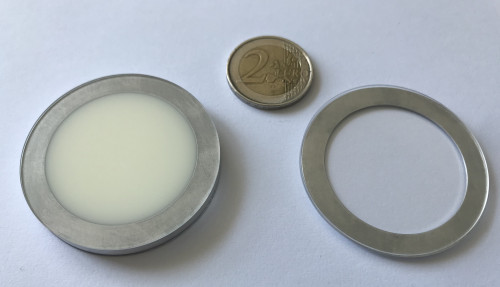
Cuvette of the SphereSpectro 150H system with special shape and small dimensions for direct attachment on the measurement port
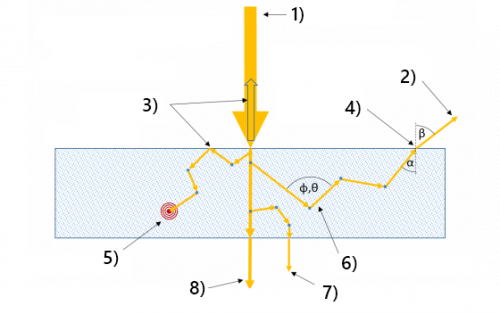
Effects of light propagation in a diffuse media
Terms: 1) Illumination; 2) diffuse Reflection; 3) Reflection; 4) Refraction; 5) Absorption; 6) Scattering Angle; 7) diffuse Transmission; 8) collimated Transmission
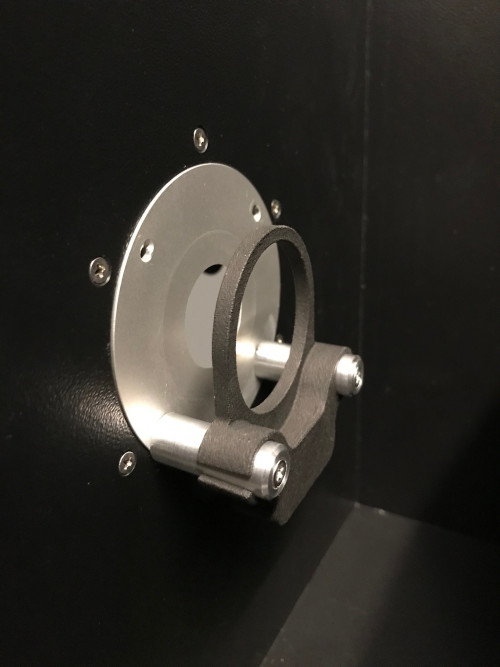
Sample chamber: Several sample holders are available. The large chamber space allows great freedom in sample design.
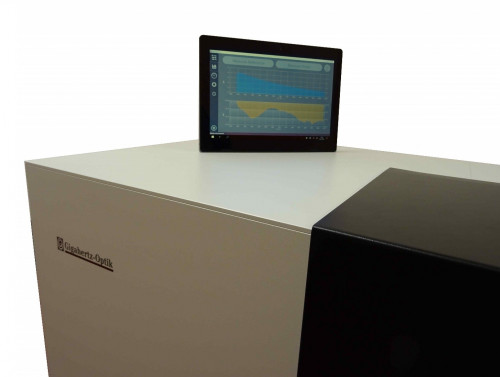
Measurement System with optional Laptop
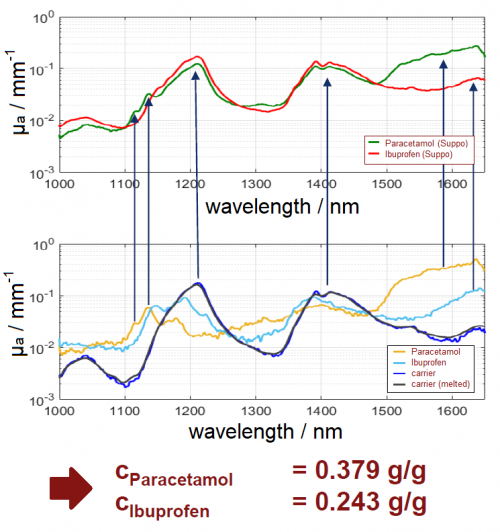
Example: Determination of the concentration of ibuprofen and parcetamol suppositories using linear superposition of the individual components
Software
Similar Products
Product Categories
